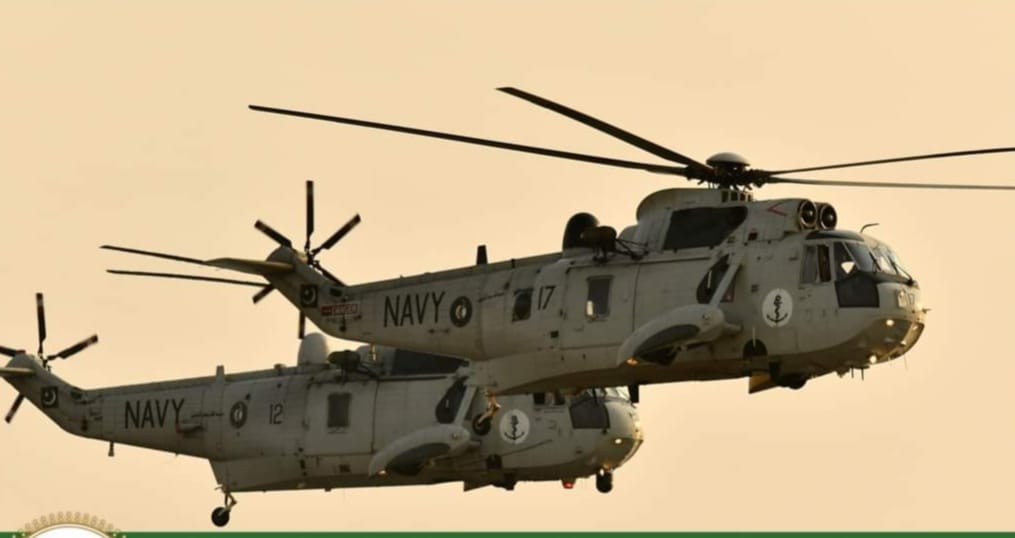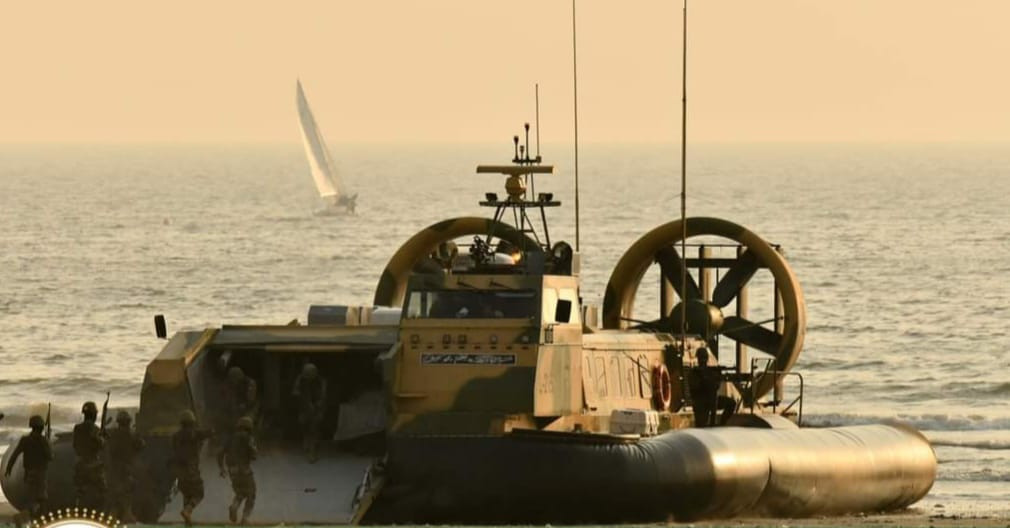Express Tribune
The military planners of most nations would look upon a vibrant and sustainable indigenous defence industry with envy. But for nations like Pakistan, hemmed as they are by persistent external and internal security challenges and with limited options to meet their defence needs, such an industrial capacity becomes all the more vital.
Since the year 2000, the International Defense Exhibition and Seminar (IDEAS) held in Karachi has provided Pakistan’s military and private defense contractors a biennial showcase to demonstrate their industrial prowess. Attracting vendors, contractors, and delegates from several friendly nations, the forum has also provided valuable opportunities to Pakistan’s defense stakeholders for technological collaboration as well as the export of indigenously developed military hardware and capabilities.
Outside of industry experts and stakeholders, each edition of IDEAS has attracted observers of Pakistan’s defence industry and capability along with a wider pool of enthusiasts. With the latest of Pakistani defence products on display alongside those foreign defence firms, the exhibition has served as an important indicator of how our country’s defence production capabilities fare in contrast to other nations.
This year’s edition of IDEAS, the 11th since the forum’s inception, came after a rather long wait. Held last week at Karachi’s Expo Centre, the exhibition took place after a gap of four years as the novel coronavirus pandemic scuppered the planned IDEAS 2020. According to the organisers, however, IDEAS 2022 surpassed all previous milestones in terms of space, booking, exhibitors and delegates in attendance, proving that the gap did little to dent enthusiasm for the fair.
Also Read: Pakistan might be building new nuclear silos, Indian officer points out
Foreign presence
In the run up to IDEAS 2022, official statements emphasised that this year’s exhibition would focus on the exchange and promotion of technology with a view to strengthen Pakistan’s strategic ties with the world community and achieve shared goals of global peace, stability and balance.
In service of that vision, over 500 international defence manufacturers set up stalls and kiosks at Karachi’s Expo Centre last week, highlighting IDEAS place as a leading international defence fair in the region. In addition to many multinational vendors, more than 260 delegates from 64 countries took part in the four-day expo, official statements indicated.
Alongside local military and private sector defence contractors, manufacturers from Türkiye. China, Europe, the Middle East, Central Asia and Africa showcased their products at the 11th edition of the fair, according to Maj Gen Mohammad Arif Malik, the head of the authority tasked with promoting Pakistan’s defence exports.
Both the US and Russia were among exhibitors in the 2022 edition, like previous years, despite the tensions between the two nations, revealed IDEAS 2022 Coordination Director Brigadier Naveed Azam Cheema ahead of the event. From Europe, three countries – Austria, Romania and Hungary – participated in the defence exhibition for the first time, showing “how successful the exhibition has remained in the past,” said Cheema.
Also Read: Pakistan should open up aerospace industry to private sector

But by far the largest foreign presence at IDEAS 2022 was accounted by Türkiye and China, two of Pakistan’s closest defence suppliers and partners. Some 28 leading defence manufacturers from Türkiye, ranging from aviation and naval sectors to firms specialising in military electronics, AI and firearms participated in the event. The top Turkish defence companies present included names such as TAI, Aselsan, state-run STM and ASFAT, and showcased products ranging from military hardware to modern drones to tactical mini-UAV systems and cyber security solutions.
The STM-Savunma Teknolojileri Mühendislik ve Ticaret AS has naval platforms and tactical mini-UAV systems for the exhibition, the company’s general manager Özgür Güleryüz revealed. The company, which is already involved in modernising Pakistan Navy’s warfare fleet, including submarines, also offers critical solutions in various segments, including naval platforms, tactical mini-UAV systems, and cyber security.
At the STM kiosk, the firm displayed the Istif (I)-Class Frigate, its Pakistan Navy Fleet Tanker (PNFT), and its STM500 – a small-sized submarine designed using national resources – to visitors. “With its indigenous engineering solutions, STM is engaged in collaborative projects, technology transfer, and business development activities in more than 20 countries, from South America to the Far East,” Güleryüz said in a statement. Commenting on the company’s participation in the event, he said: “While equipping the Turkish Navy and Turkish security forces with innovative and national systems, we share our experience and engineering capability with friendly and allied nations.”
STM, together with ASFAT, has been involved in a number of key projects over the years. It built and delivered PNFT MOAWIN, a Navy Fleet Tanker designed for the Pakistani Navy in Karachi in 2018 as part of a project aimed at building a military ship with the biggest tonnage abroad. “In addition, we are continuing with the modernisation of Pakistan’s Agosta-Class 90B submarines,” Güleryüz said, adding the company has already delivered the first submarine under the said project, while the modernisation of two remaining submarines is continuing. This is STM’s first time acting as the prime contractor in a submarine modernisation project being conducted in a foreign country. Currently, the STM is taking part in a project for the production of four Ada-Class Corvettes for Pakistan.
Also Read: SUPARCO joins hands with Turkish Aerospace Industries to develop satellite projects
AI and drones in spotlight
Recent conflicts, from Azerbaijan and Armenia to the ongoing war in Ukraine have revealed how vital drones and other automated or remotely operated weapons systems have become to the art of modern warfare. With new developments in the realm of aerial drones and artificial intelligence (AI) demonstrated day after day, the 2022 edition of IDEAS too focused on the two emerging technologies in the context of defence and security.
At the seminar titled ‘Artificial Intelligence (AI) in Defence Market: A Paradigm Shift in Military Strategy and National Security’, organised as part of IDEAS 2022, discussion centred on the need to transform Pakistan into a global hub for AI, data science, Internet of Things (IoT), virtual reality and other emerging technologies. Emphasising research and development, speakers acknowledged that universities can play a key role, combining the expertise of different stakeholders.
“The country can become a global hub for AI, data science, cloud-native computing, edge computing, blockchain, augmented reality, and IoT by reshaping and revolutionising education, businesses and research through the adoption of cutting-edge technologies and AI-driven applications,” noted Federal Minister for Defence Production Muhammad Israr Tareen. “Developments in AI have also changed the dynamics of modern warfare… the concept of security has widened beyond traditional understanding,” he said.
On the subject of drones, Pakistan’s indigenously developed Shahpar II unmanned combat aerial vehicle was displayed the Global Industrial and Defence Solutions (GIDS) stall at IDEAS 2022 alongside the Barq laser guided air-to-surface missile it can be used to launch. GIDS is a state-owned organisation operating under the patronage of Joint Staff Headquarters mandated for the exports of defence products in the international market.
Also Read: Turkish Aerospace Industries to establish a high-tech aviation lab at NUST University
Pakistan’s first indigenous anti-ship cruise missile Harbah-NG was also displayed at the GIDS stall with an eye towards exports. GIDS officials also said they have invented an Integrated Electronic Warfare System which helps forces to sense, protect and communicate within a radius of 30-35 kilometres. “We have produced the system at the one-fourth cost against what Pakistan used to pay to import it earlier,” a GIDS official said. The communication system works on radio signals. It improves the capabilities of the forces in combating against enemy’s aggression.
In addition to the Shahpar II, companies from China and Türkiye displayed their own drone models, ranging from tactical mini-UAVs to larger more heavily armed types. STM, which produces leading and competitive platforms in the tactical mini-UAV system market segment, introduced the KARGU, Türkiye’s first mini-attack UAV; the TOGAN surveillance UAV system; and the ALPAGU fixed-wing attack UAV system, to the South Asian market.
“We have never seen (military) drones from such a close range before. They are simply impressive,” Arif Jameel, a retired government official who visited the Turkish pavilion with family, told Anadolu Agency. “And I have never seen such huge drones before,” his wife, attired in a black gown and matching scarf, said in a lighter tone as an STM official briefed a group of Pakistan Army officers on the technology and operation of drones.
From the civil sector, Woot Tech, a Pakistani aerospace company that designs and manufactures innovative and customised drone technology solutions and provides services for a broad spectrum of applications for industrial-strength commercial use, displayed its own series of indigenously designed drones.
Also Read: Should Pakistan have a cyber army?
Attractions old and new
Without a doubt, the most striking static displays greeted visitors immediately upon entering the IDEAS 2022 venue. Outside the halls housing stalls for local and foreign military contractors, were displayed some of Pakistan’s flagship defence products, including the JF-17 Thunder fighter jet and the Al-Khalid I main battle tank.

With work underway to induct the most advanced Block 3 version of the JF-17, the Pakistan Air Force put on display the Block 2 model which was part of the fleet that downed two Indian aircraft in retaliation to New Delhi’s aggression in February 2019.
Inside, at the Heavy Industries Taxila (HIT) stall, Pakistan showcased its latest main battle tank called Haider, “which is capable of firing a laser-guided missile with an effective hitting target range of 5 kilometres,” said an HIT official. The Haider MBT was introduced in the recent past and inducted into the Pakistan Army fleet. “This has improved the capability of Pakistani forces on battlefields,” the HIT official said. “This is the most advanced battle tank introduced after the Al-Khalid tank.” The tank is also capable of going into hiding by generating smoke when it senses a counterthreat. This is an auto gear tank with the steering to move it right and left, replacing the old technology of sticks to do so, he said.
Alongside HIT, a Pakistani private sector firm displayed its own series of armoured vehicles aimed at the military, security and law enforcement market. A bombproof armoured vehicle was among the main attractions at the expo and a Middle Eastern country was said to have placed orders for the purchase of the vehicle which, according to the manufacturer, can withstand an explosive device of up to two kilograms.
The armoured vehicle is also equipped with a high-definition 360-degree camera. “We have supplied 24 bombproof vehicles to the armed forces within a year while more vehicles are on the assembly line,” Khalid Yousuf, CEO of the private manufacturing company, told The Express Tribune.
In addition to static displays at the Karachi Expo Centre, a spectacular demonstration of Pakistani forces’ skill was arranged at city’s Sea View beach as part of IDEAS 2022. The skies echoed with the roar of the fighter jets and helicopters as contingents of Pakistan Air Force, Pakistan Navy, and Pakistan Army took part in an airshow, beach landing, anti-terrorism mock exercise and other displays of tactical prowess.
During the show Pakistan Navy’s amphibious force, marines, and Special Services Group of Pakistan Army presented a special anti-terrorism demonstration signifying their professional training. A joint counter-terrorism demo was also made comprising fly past and free fall jump by soldiers of the three armed forces. Forces personnel performed beach landing speedboats and hovercraft. During the demonstration, commandos rappelled down to the beach from Sea King helicopters.
Also Read: Phage Therapy: War of Viruses against Bacteria, since 1917
The next generation of Pakistani firearms
While the ‘big guns’ like the JF-17 Thunder jet, the Al Khalid and Haider tanks, and the wide range of indigenously developed armoured personnel carriers and other vehicles grab headlines, equally attractive to visitors are the various displays of modern firearms from both local and foreign defence manufacturers.
At IDEAS 2022, the Pakistan Ordnance Factories (POF) displayed its latest family of automatic rifles, which could perhaps eventually replace the venerable G3 in service in Pakistan’s military and security forces. The BW-20 battle rifle and the related CW-56 assault rifle were displayed in various versions aimed at filling several battlefield niches, from snipers and marksmen to grenadiers.
According to firearms experts and industry observers, the BW-20 rifle and the similar CW-56 employ the same mechanism as the G3 rifle. However, the weapons appear to be more than a simple upgrade the Pakistan military’s mainstay firearm, representing an original design that could be produced using existing infrastructure used for manufacturing G3 rifles. The BW-20 also appears to follow a simplified design and is believed to consist of 125 parts as opposed to the original G3’s 200 parts.
In addition to POF, other Pakistani firearm manufacturers presented their wares as well, including an M4-type rifle developed by a private sector firm and an indigenously designed multi-barrel grenade launcher.
Also Read: Turkish Aerospace Industries to establish a high-tech aviation lab at NUST University
Integrating public and private sectors
As he inaugurated IDEAS 2022 as chief guest, Foreign Minister Bilawal Bhutto Zardari stressed that Pakistan offered enormous opportunities for profitable investments, joint ventures and trade in all sectors, including the defence industry. He added that though Pakistan was exporting high-tech defence products to more than 60 countries, the volume of exports did not commensurate with the country’s actual potential because of the limited involvement of the private sector and lack of attention to academia interface.
“In order to achieve this goal, I will stress the integration of the private and public sectors to achieve maximum results,” the foreign minister told the participants. On the occasion, he urged the small and medium industries to “join hands” with the defence industry.
Bilawal emphasised the vital role played by technologies in confronting modern-day security challenges. “Its responsible use can make the world a better and safer place,” he stressed. “Pakistan, being a responsible state, is always committed to play its role for international peace, stability and order,” he said.
In the regional context, he maintained that the transformation of the South Asian geo-strategic environment had further accentuated the importance of the region in the world affairs. “Resultantly, regional cooperation and active engagement with regional and global players has become imperative,” he added.
However, he cautioned that with the rapid advancement in technology and proliferation in knowledge “we are facing a physical change in the established security paradigm”, adding that the increasingly complex security environment of the world posed multifaceted threats to national security and the stability of the country.
![]()





